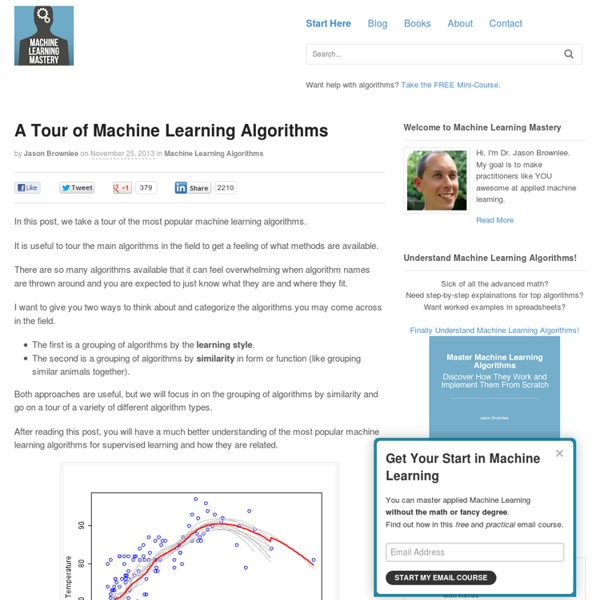A Tour of Machine Learning Algorithms

A Visual Introduction to Machine Learning
Finding better boundaries Let's revisit the 73-m elevation boundary proposed previously to see how we can improve upon our intuition. Clearly, this requires a different perspective. By transforming our visualization into a histogram, we can better see how frequently homes appear at each elevation. While the highest home in New York is 73m, the majority of them seem to have far lower elevations. Your first fork A decision tree uses if-then statements to define patterns in data. For example, if a home's elevation is above some number, then the home is probably in San Francisco. In machine learning, these statements are called forks, and they split the data into two branches based on some value. That value between the branches is called a split point. Tradeoffs Picking a split point has tradeoffs. Look at that large slice of green in the left pie chart, those are all the San Francisco homes that are misclassified. The best split Recursion
Start Here
Get Started and Get Good at Applied Machine Learning Hi, Jason here. I’m the guy behind Machine Learning Mastery. My goal is to help you get started, make progress and kick butt with machine learning. I teach a top-down and results-first approach designed for developers and engineers. This is unlike most academic textbooks and university courses. Access my best free tutorials on the blog or take the next step with my paid training material. You may be feeling overwhelmed. Take your time. Table of Contents What do you need help with? How Do I Get Started? The most common question I’m asked is: “how do I get started?” My best advice for getting started in machine learning is broken down into a 5-step process: For more on this top-down approach, see: Many of my students have used this approach to go on and do well in Kaggle competitions and get jobs as Machine Learning Engineers and Data Scientists. Applied Machine Learning Process For a good summary of this process, see the posts: R Machine Learning
ConvNetJS: Deep Learning in your browser
ConvNetJS is a Javascript library for training Deep Learning models (Neural Networks) entirely in your browser. Open a tab and you're training. No software requirements, no compilers, no installations, no GPUs, no sweat. Description The library allows you to formulate and solve Neural Networks in Javascript, and was originally written by @karpathy (I am a PhD student at Stanford). Common Neural Network modules (fully connected layers, non-linearities) Classification (SVM/Softmax) and Regression (L2) cost functions Ability to specify and train Convolutional Networks that process images An experimental Reinforcement Learning module, based on Deep Q Learning. Head over to Getting Started for a tutorial that lets you get up and running quickly, and discuss Documentation for all specifics. Code The code is available on Github under MIT license and I warmly welcome pull requests for new features / layers / demos and miscellaneous improvements. Discussion Group
Introduction to Strategic Thinking
Starts June 22, 2015 This is a short interdisciplinary course on strategic thinking and some of its most powerful tools. Strategic thinking is not exclusive to business or military applications. We will draw lessons and use concepts from economics, game theory, scenario planning, behavioral sciences, and futures studies, as well as philosophy and linguistics. This course is designed to be a starting point for people who are just beginning to learn about strategic thinking. "Fascinating course. "The course was very enlightening! "Thank you for the stimulus and providing a completely different approach from what I was expecting from this class." "I come from a background where I learned, used and taught military doctrine and decision making and I therefore confidently entered into this course expecting to have my expertise confirmed and (possibly!) Sandjar Kozubaev Economist & Strategist Sandjar Kozubaev is an economist and a strategist.
Simple machine learning: bot detection
Related:



